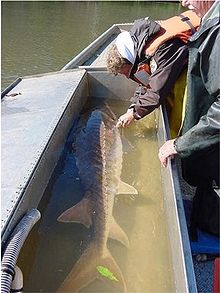Gulf sturgeon
| Gulf sturgeon | |
|---|---|

| |
| Gulf sturgeon on side | |
| Scientific classification | |
| Domain: | Eukaryota |
| Kingdom: | Animalia |
| Phylum: | Chordata |
| Class: | Actinopterygii |
| Order: | Acipenseriformes |
| Family: | Acipenseridae |
| Genus: | Acipenser |
| Species: | |
| Subspecies: | A. o. desotoi
|
| Trinomial name | |
| Acipenser oxyrinchus desotoi | |


The Gulf sturgeon (Acipenser oxyrinchus desotoi) is a
Physical appearance
Visually, Gulf sturgeon are almost impossible to differentiate from Atlantic sturgeon, as the most significant morphological difference is the
Life cycle
Juvenile Gulf sturgeon remain in the spawning river until roughly two years of age, eating there. Thereafter, they join the adults in their anadromous
Jumping
All species of sturgeon leap out of the water at times. The Gulf sturgeon tends to jump during July and August, and again early during the offshore feeding period. They are thought to jump to communicate and maintain group cohesion.[8] Due to their heavy body armor, large leaping sturgeon can inflict serious injuries to humans who are in the way.[9] On July 2, 2015, a leaping sturgeon on the Suwannee River in Florida struck and killed a 5-year-old girl.[10]
Population controls
References
- . Retrieved 13 May 2023.
- ^ a b "Gulf sturgeon (Acipenser oxyrinchus (=oxyrhynchus) desotoi)". Environmental Conservation Online System. U.S. Fish & Wildlife Service. Retrieved 13 May 2023.
- ^ a b Fish and Wildlife Service; National Oceanic and Atmospheric Administration. "Endangered and Threatened Wildlife and Plants; Threatened Status for the Gulf Sturgeon". Federal Register. 56 (189): 49653–49658. 56 FR 49653
- JSTOR 1446867.
- ^ a b c Fish and Wildlife Research Institute. "Facts About Gulf Sturgeon". Florida Fish and Wildlife Conservation Commission. Archived from the original on 2007-07-15. Retrieved 2007-08-31.
- ^ Fish and Wildlife Service; National Marine Fisheries Service (2003). "Endangered and Threatened Wildlife and Plants; Designation of Critical Habitat for the Gulf Sturgeon" (PDF). Federal Register. 68 (53): 13370–13407. Retrieved 13 May 2023 – via govinfo.gov.
- ^ a b c d U.S. Fish and Wildlife Service; Gulf States Marine Fisheries Commission (1995). Gulf Sturgeon Recovery Plan (PDF) (Report). Atlanta, Georgia: Southeast Region, U.S. Fish and Wildlife Service. Retrieved 13 May 2023 – via Environmental Conservation Online System.
- ^ a b Lovgren, Stefan (2006-10-30). "Mystery of Florida's Giant Jumping Sturgeon Solved?". National Geographic News. National Geographic Society. Archived from the original on November 13, 2006. Retrieved 2007-08-30.
- ^ Bester, Cathleen. "Biological Profiles: Gulf sturgeon". Ichthyology at the Florida Museum of Natural History. Archived from the original on 18 June 2015.
- ^ Fieldstadt, Elisha (5 July 2015) [Originally published 4 July 2015]. "Leaping Sturgeon Kills 5-Year-Old Florida Girl Boating With Family". NBC News. Retrieved 13 May 2023.
- Froese, Rainer, and Daniel Pauly, eds. (2009). "Acipenser oxyrinchus desotoi" in FishBase. February 2009 version.


